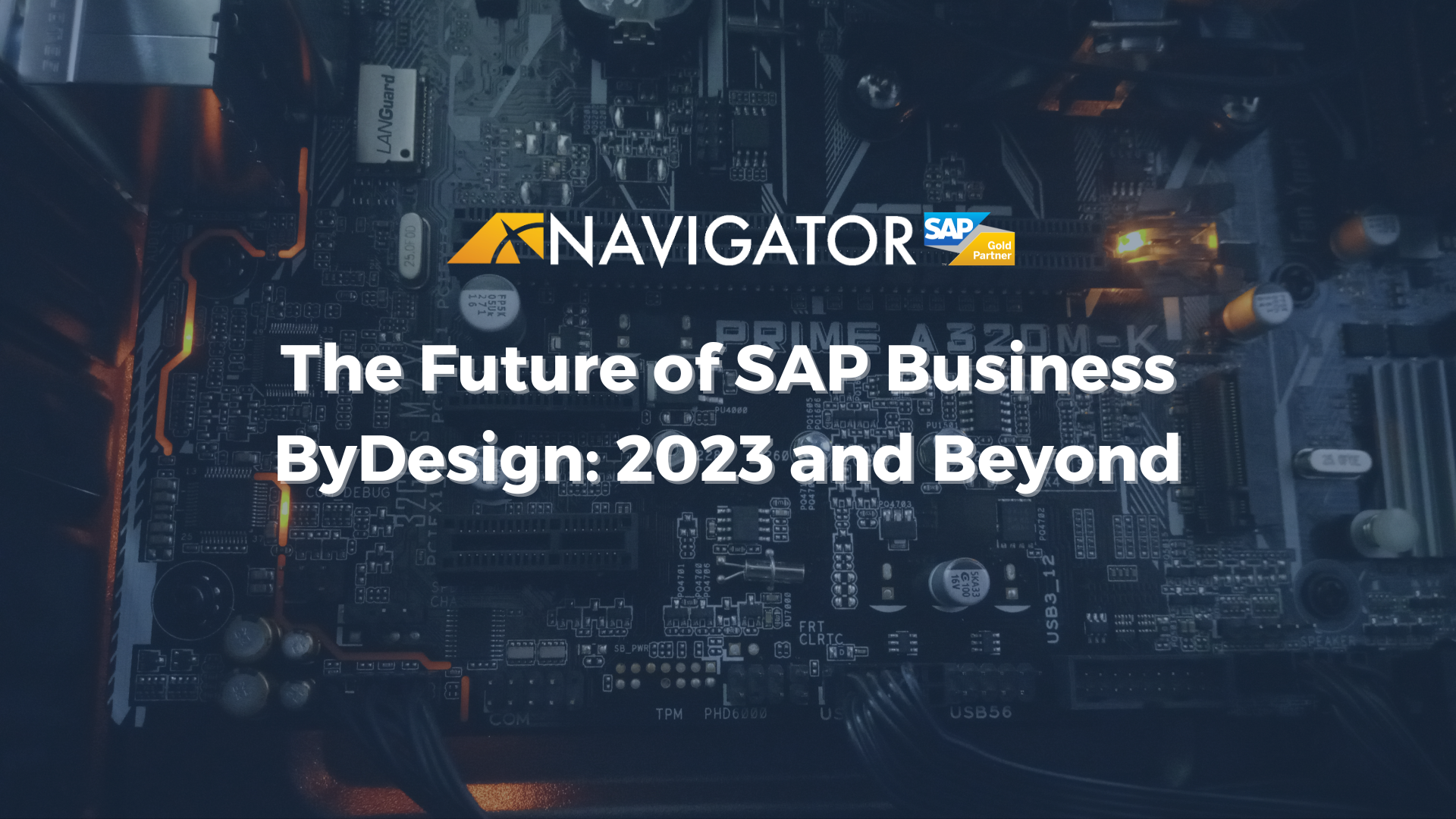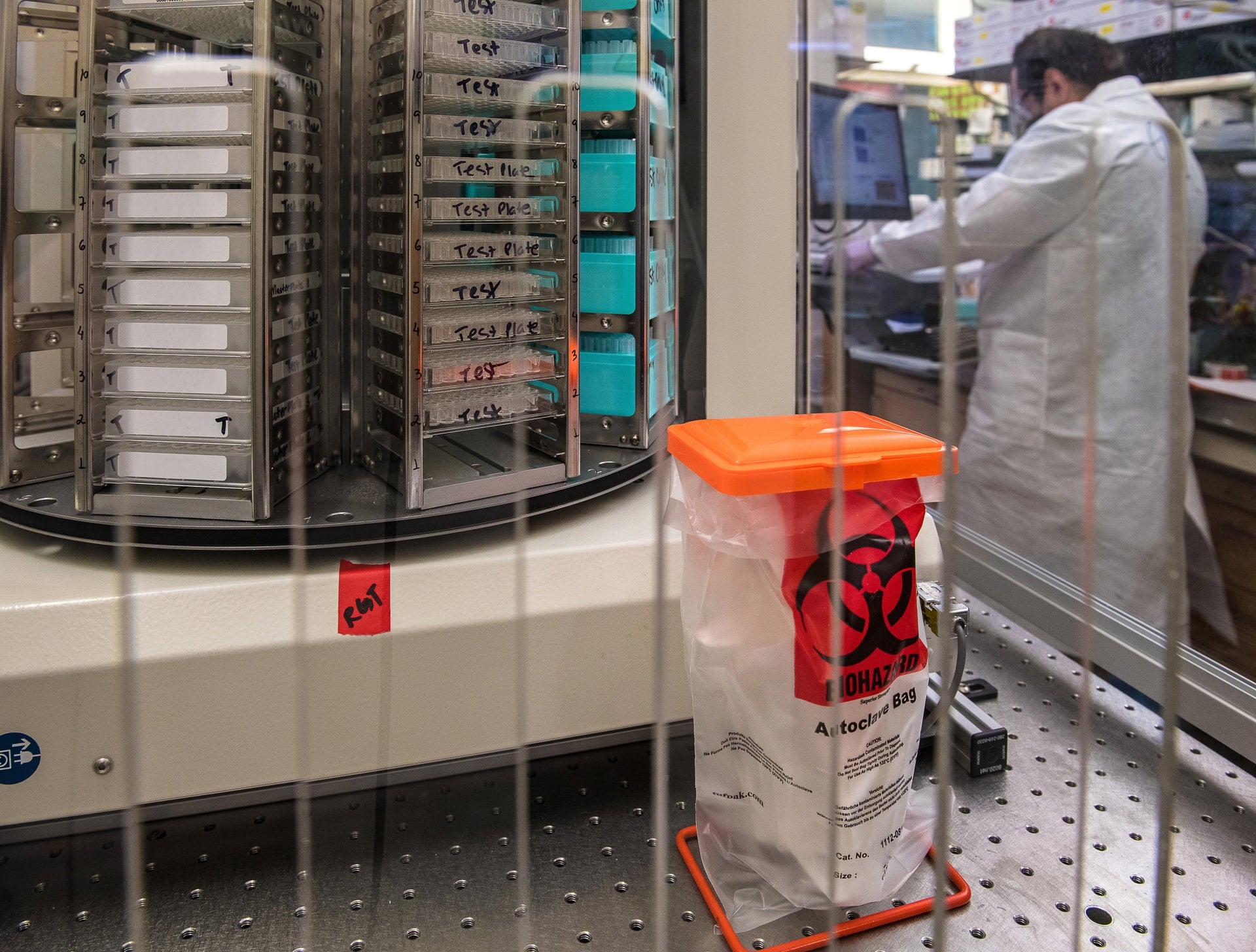Explore SAP ERP for Life Science Organizations
Welcome to Navigator's ERP considerations for accelerating life science organizations. My name is Ralph Hess. I'm executive vice president of sales, marketing, and presales here at Navigator Business Solutions. And I'm really delighted to be able to spend the next 30, maybe 35 minutes with you. We wanna make this a, a really high value presentation. So as we go through things, feel free to post questions that you may have using the question bot in the right hand portion of your panel. And if I can address them during the course of the presentation or at the end, we'll certainly get back to you with answers to those questions.
So who is Navigator? I'm sure that a number of you are here knowing a little bit about us, but Navigator is an SAP partner. We are a distributor of their cloud-based ERP solutions. And we have a high degree of specialty in life sciences. Now life sciences is a, large kind of industry designation. And we'll talk a little bit about some of those areas that we specialize in, but typically life science organization will come to us when they're trying to grow and their systems or their processes are holding them back from the future they want. That can either be a startup biotech somebody with an idea that has funding that knows that they need to get an ERP solution in place, or it could be a mature organization that has outgrown the solution that they have and need to take that to the next step. We are exclusively an SAP partner. We're the number one ByDesign partner globally. We have done this before with great success. We use a preconfigured package based on SAP Business ByDesign, which enables companies to grow from pre-revenue to and through cGMP and full commercialization and validation. And we have a number of success stories that we can share along the way.
So what are the questions that we usually hear when we engage with life science companies? When they talk about ERP oftentimes it's finance that may be driving the bus a little bit in terms of what the requirements are, but very closely after that come in the operations teams, the quality teams, et cetera. And so really the mix of, questions that we get are, you know, what about track and trace? Can this solution support that? What about EBRs or electronic batch records? Ebrs electronic device history records. What about quality? You know, can we integrate with our lab testing solution? Do you support GMP? What about validation? The 21 CFR part 11 do you offer validation services? What about enterprise asset management, preventative maintenance, those types of things. So really our customers come to us with a variety of questions that at times fall outside the realm of some typical ERP solutions.
We're going to try to answer some of those questions today, both in terms of presentation and actually showing you the solution so that you have a better idea of what the answer to those questions are using ByDesign from SAP, which becomes the digital core of the platform that we bring to the table now ByDesign is a cloud based ERP written by SAP. About 13 years ago, they brought the best of what they knew from the large enterprise, reimagined it into an easier to consume and configure platform. And it is what we call a suite in a box approach, meaning that everything that you need at a, base level is included in a subscription when you first acquire it, it has pre-built end to end process scenarios. It is multi-company multi GAAP. So it's particularly well suited to multinational and multi entity corporations.
And as you can see from the ribbons across the side wrapped around the box, we do have core functionality for HR financials, supplier management, CRM, supply chain, project management, plus solution extensions, which we'll talk about in just a few moments. This is all delivered on a very innovative, very current, very modern platform. It's mobile enabled. There is built in predictive analytics. It has e-learning, which is delivered embedded workflow, very well documented and for ease of integration, a very open architecture. So there is 200 and some odd open APIs. So that integration with point solutions external to the digital core become an easy process to go through. The last two, there are, the fact that it's secure in global are two things that our customers and life sciences are really looking for. So whether you're manufacturing in a complex supply chain around the globe ByDesign can support you. If you have concerns about GDPR data security, any of that, it's housed in very highly secure SAP data centers globally.
Now, why is SAP business ByDesign the right fit? So we have over 15 years of experience implementing ByDesign in these types of what's just called them regulated environments, FDA regulated environments. And we have customers across the life science spectrum from viral vector manufacturing, gene and car T cell therapy, cell banking, sterile fill, finish pharmaceutical manufacturing, and distribution med device and distribution. So as you can see, when I mentioned that when we talk about life sciences, we're talking about kind of a broad industry designation. We have expertise in all of these particular areas. We do have full alignment and support from the SAP life sciences team. So we really partner closely with them to identify what the right solution is for the prospect is if you're very large and you require it well, we're going to talk about the, large enterprise version of, of SAP, which is S4HANA.
Increasingly as the year goes on, we'll be talking about S4 public cloud. But what we look to align on are those opportunities in those scenarios where really it's a company that can be best served by SAP Business ByDesign. We do have an SAP qualified partner package, which is developed specifically to support life sciences. So as you saw me talk about the digital core, we have added our own intellectual property. And when I show it to you, you won't be able to tell whether it's from SAP or whether it's from Navigator for electronic signatures business partner and product restrictions, CAPA, outsourced manufacturing additional track and trace capabilities, advanced quality and advanced warehouse management. What we did was identify some of those areas where ByDesign needed to have some advanced functionality added to it in order to meet some of the, highly demanding requirements of the life science industry.
Now, what are the features that are out of the box that make it particularly good? But I talked a little bit about that. It's, multi-company, multi-country, multicurrency right out of the box. You don't have to add another version of the solution to be able to support that right out of the box. It manages complex supply chains. So if you have one of those supply chains where perhaps your, your manufacturing APIs in another country, you're bringing it in, you're doing some final processing or some final assembly of components manufactured in other countries. It can handle all of that. It has identified stock, which we commonly known as lot and batch controlled and registered projects products for serialization, from a track and trace perspective. And there's a fully embedded production within the supply chain portion of the solution that supports cGMP for both discrete and process manufacturing.
So it's very good at, at either or a hybrid of both of those. It has embedded quality control. It has embedded warranty tracking for med device folks. It has embedded service management capabilities. It is a ready to validate platform and it comes with prepackaged SOPs. So those are all the things that you can count on just by opening the box and installing the software or in the case of a cloud solution you know, registering the the tenant itself in terms of compliance, because as we're moving into these, industries that, have this high degree of FDA surveillance we have full and complete track and trace via the lot batch and serial number, user authorization and login control management. Every transaction is marked with a date, time, user, that created it. There's a change log maintained for every update to a document or master file record. It has strong bill of material revision control and variance support, integration to EQMS integration to network track and trace solutions. And again, those prepackaged SOPs, which are based upon the life science industry that help facilitate the validation process.
Now I talked about what's out of the box as we engage with our customers, and as they grow, there's oftentimes the need to integrate with some additional pieces of software. Whether that be their laboratory information management system we just have LabWare here as an example whether it's a preventative maintenance or enterprise asset management solution, like Fiix from Rockwell international, whether it's a QMS or a manufacturing execution solution from MasterControl or others. Of course, SAP delivers the internet of things right out of the box and as part of the platform, as well as some intelligent robotics and bots and things like that we have integrated with TraceLink for network supply chain tracking. And then we have process validation using our partner, the Arbor group which is a, renowned organization for purposes of providing that, that FDA validation service.
So we've talked a lot about it. Why don't we actually dive in now and take a look at some of those key elements that we just talked about? So I'm just going to exit my PowerPoint and we'll dive right into the software itself. Now, as I've logged on, I've logged on with a particular user profile. So all of the logging controls, password controls, et cetera. All of those things that are part of 21 CFR, part 11 are all available directly out of the box in the, controls of the access to the solution. And as I've logged on, I've personalized this particular launchpad for purposes of, of this particular webinar as, as well. So as you take a look, you're going to see things that make sense to be able to show you a little bit about, but let's talk about navigation.
What we're looking at here is what we refer to as the launchpad. The launchpad is something that you can personalize, meaning that you, as a user can adapt, add buttons, to add tiles, to add analytics, to, to make it the most productive environment for you. We also have, if we expand the three lines here, what is called the work center area now ByDesign is called calls these work centers rather than modules, because there's a really unique aspect of ByDesign that really is not able to be equaled by, by other competitive solutions. It all built at the same time. So, it wasn't a finance solution that they then added supply chain too, that they then added a manufacturing solution to that they added a service module to, it was all built cohesively at the same time. So as we take a look at any of the different work centers we can access those.
So I can either get at a particular function by clicking on one of the buttons, or if I wanted to go into one of the one of the areas I can go into things like sales orders, you see that expands and gives me the most frequently used portions of the solution or that particular work center in that area. I also have the ability to establish a, list of shortcuts. So if I don't like to work on tiles, if I don't like to work, in a kind of a menuing system, like the, work center area, or provides me, then I can just create a list of, of fast shortcuts that I can get to as I'm going throughout the solution.
So let's, and I think what this is really showing you as I look at this, you're going to see a lot of different work centers here. You're gonna see them go all the way through my, inbound supply chain, my outbound supply chain. You're gonna see things about quality, about project management, payroll processing, all my financials, receivables, payables, liquidity management, payment management, general ledger. I just want, I'm not gonna dive into any of those, but I want you to understand that that's that suite in a box approach, everything is there that you need, you access them by configuring them through the business configuration option. So the way the system is scoped and configured for you is using the business configuration option. It's not coding, it's not scripting, it's actually using a set of checkboxes as part of the business configuration.
So let's just kind of collapse that, and let's go through some, just kind some menu walkthroughs or some, functional walkthroughs. So you can see some of the key points that we were talking about earlier in the slides, as we take a look at it, I've, grouped some of these options from my work centers into groupings of tiles. And I can do, I can create my own groupings as I want using the personalization mode. I'd invite you to attend one of our webinars on, the general ByDesign solution to kinda get up to speed on that. But as you notice, I can go ahead and bring those rows into focus as I just tap on those groups as I'm moving across the top of, of the solution. So let's just quickly go into a little bit about production models.
So what I wanna do is, take a look at a production model, and you can, understand this as really production model brings together a bill of material and a bill of operation to create a version of what we call a production model production models are then used to actually create the work orders that are released to the floor. Well, let's take a look. You can see, I have a few of them here, but what I'm most interested in is this BF1101-3. And this is an example for one of our, viral vector manufacturing solutions or implementations that we did. And this is some downstream purified API. So as we take a look, my production model is bringing together product. It's bringing together a bill of material, and it's also bringing together a bill of operation.
So if I just go in and edit this quickly, I just wanted to use this to be able to show you a little bit about the various elements of, the master data that we have within the solution. So here I have my production model. It is bringing together a bill of operations. So as I'm looking at my bill of operations, you can see there's various really configuration points here about how I want to be able to execute in the operation on, this particular bill of operation. But let's, let's just go into this, what we call a BOO. So I'm going to click on the view all button, so that it gives me a little bit of a better understanding of, the structure of it. So one of the things that I wanted to show was that we do have our general information about the bill of operation, which some may consider what we call routing.
And what I wanted to show in the structure was that I do have the ability to have multiple steps so I can have single step or multiple steps. I can have branching within that, bill of operation. But what I wanted to show was that we have integrated quality throughout the solution. So and we'll, visit on that in just a moment, but as we take a look, I wanted you to see that I have a make operation, and then I have a quality check operation. And when we visit into quality, you'll see the inspection that actually gets created or triggered as part of reporting the production out of this bill of operation. So let's go ahead and close that. And then I wanted to show you the product assignment, which is essentially the bill of material, which is, being spread out over, the course of that execution of that particular production model.
So just wanted to give you a little bit of an idea of that, of, what a, bill of operation looked like. The fact that it has the embedded quality in it, which is important. And what's actually, one more thing I wanted to just show was go into the bill of material as well, show you a little bit about the bill of material. Again, I'm gonna click on the view, all which exposes the majority of the information to me, what you're seeing is regardless of which screen I'm going into, I have continuous, repetitive, you know, kind of the same look, feel, same action, that type of thing that I can take. So on the bill of materials, some things that I wanted to be able to show you was the fact that I, do have multiple variants, so I can have multiple variants of the same bill of material.
In this case, I have one that I've performed that I created, and I have a second one that is undergoing some, some process. I can take a look at what the input products are for that particular product. You can see any of the additional information about it, any of the item changes, and I have engineering change orders as well. So as I make any changes to this particular product, it's going to require an engineering change order be assigned to that change. We do have engineering change order approval processing as well. So you have a well structured and a well controlled environment. One last thing I wanted to do was just drill into the material master as we refer to it again, I'm going to click on that view all button and the view, all button is going to show me some, some key elements.
So just some points that I wanted to point out here was that we obviously have the, an item, an item coding scheme, we have product descriptions, additional product descriptions. What we can do also is assign different types of tracking. So I can have things be lot tracked. I can have it optional specified stock, meaning that I can create different product specifications. If I'm manufacturing this particular product for multiple customers, I can have a different set of specs for each one of those customers. In this case, we're saying it's batch managed. And I also have the ability to do serialization, so I can define at what level I'm going to serialize. Am I gonna serialize throughout all of my logistic processes or not no serialized assignment, or if I just wanna do it as we're sending things outbound. So a little bit about the how we establish the controls that we're looking for.
As we take a look at some of the planning elements what you're seeing here is I have multiple sites that this particular product is going to be stored and, processed in. And what this planning allows me to do is do things like define what the source of supply is, whether it's in-house production, whether it's externally purchased, whether I'm procuring it from another one of my facilities. Again, there's a whole level of detail I can go in there, but just wanted to kind of touch on that for a little bit. I have quantity restrictions as well, so that if I have any restrictions over a given period or restrictions on a given quantity, that needs to go on an order when it's going to a particular location, I can establish the baseline of that. And then fully let's say configure that as part of our customer restrictions as well.
But the last piece that I just wanted to quickly show here was the changes. So what I indicated to you was that there was a change log maintained for each and every change that was made t data on a particular master record or an order or a record. So as we take a look here, you can see, this is obviously a, a pretty old item that we've, that I've selected, and you can see all the different changes that have been made over the course of time. So I have it date, and time stamped. I even have a log of what data changed on each record as I'm looking at it. So those are just a few of the points I wanted to say, that's where you establish what items are going to be track and traced. It shows you a little bit about the embedded quality, which we'll touch on in just a moment. And it, also shows you that change log capabilities that I referred to.
So let's now quickly go into talking about quality because oftentimes in life science quality is one of the key constituencies that drives the bus. So within SAP Business, ByDesign another way of navigating that I'm just pointing out here is I have this type of head search for functionality. So as I take a look, I have my out-of-the box quality, which allows for quality planning, which is the creation of quality inspection plans and that type of thing, my quality control, which is my work center for being able to monitor what inspections need to be performed. And then Navigator has created an advanced quality solution, which we'll talk about in just a moment. So as I take a look at quality control, I'm going to just quickly go into my inspections. And what I'm going to see is I have if you remember, I had an inspection step on my bill of operations.
When I completed that when I reported some output on that particular production order, it will automatically trigger based upon my final inspection setup of this particular inspection plan to actually trigger an inspection, send an alert, say it needs to be inspected. So as I drill into this particular inspection, it's going to access the inspection plan that I've set up for this particular product. If I were to just go into that inspection plan itself, you'll notice that I can easily drill in and around. So I have this inspection to perform. It's essentially telling me, Hey it's based on this inspection plan. And just to give you a view of what inspection plans look like. This gives me the opportunity to establish what inspections, my sampling size, my sampling criteria and any quality codes that I might wanna establish. Again, I have that change log.
I have any notes and any attachments, inspection plans things like that. So that's a little bit about the in just again, that's the inspection itself. If I now go in edit this, because I want to record my results, what you're going to notice really is, is a couple of different things. So here it's asking me for my results, the decision I'm going to make any miscellaneous information that I want to record for it, what this is also showing you is what we call the document flow. So throughout this solution, you have this document flow, which is kind of a chain of events that has happened. So there was a production request. The production request was released. It created a production order. And as a result of that production order, starting activity it triggered this inspection. So again, you have that traceability and that's throughout the system, regardless of, of what, what you're looking at.
Two things that I just wanted to point out here is that we have our e-signature pin requirements. So this is the electronic signature logic that we've added to SAP Business ByDesign. And then we also have the ability to create a CAPA case right off of this inspection as well. So out of the box, we're providing the inspection and quality capabilities that are needed really at a base level. And when we understood as we took this into perhaps some larger and more sophisticated organizations we understood that there needed to be some additional functionality for quality fleshed out. And so, as we undertook that we, we consulted with a number of our clients who had actually come down from larger SAP solutions, understood where the gaps were between that larger solution and ByDesign's quality and have come up with this advanced quality module.
So as we, as we take a look at the advanced quality planning what it's really doing is bringing the whole concept of some additional qualitative testing results being able to establish characteristics, being able to have email workflow, distributions printing of labels and documents and has its even its own subset of the Esignature. Again, we'll be doing a separate webinar specifically on that module as well. Now I know I'm running a little bit long, but I'm hoping that you can stick with me through through the main remainder of what I'd, what I'd like to show here. So I'm just going to collapse the, the work center. And what I'm going to do is we'll go ahead and look. One of the things that I wanted to show from a track and trace capability was this ability to do what we call a, an enterprise search.
So you'll notice up here, I can search for anything throughout the system. And what I did was rather than type it, I just kind of copied and pasted that particular identified stock or batch batch code. And what I was able to do was take a look at everything that has happened to that batch. So I can take a look at all categories. I can take a look at specific business documents. I can, if I want to drill into that identified stock record and take a look at it, I can see right now where it's being stored. I can see what it's called. I can see any attachments. So there was a certificate associated with that. And if I wanna show the details of what's occurred to that particular batch or lot, I can see that. So here we made it, we transferred in between. We picked it and we went and shipped that to a customer. So as we take a look at it again from a track and trace perspective, you have the ability to be able to see everything that's happened to a lot to a serial number, et cetera.
So, and that's using the enterprise search that's without having to go into the work center. So if you have to do a, a quick look up on something, because somebody makes you a call, you have, you have the ability to be able to do that. Now on all of that quality, obviously reporting becomes a big piece of it. So as I take a look at some of the out of the box reports that we have for inspections, you can see that these are views, which are created directly by SAP. You have your inspection analysis, lead time by inspection type per week quality score by inspection type per week, top 10 critical suppliers, number of inspections. So what I wanted to help you understand was right out of the box by SAP. There's very good insight into the quality and the results of the quality that are occurring in the system.
Now, just really the last piece that I wanted to touch on is to take a look at I, I did make mention of the fact that we have a CAPA module. We have a recalls module. We have supplier what we call the ASL or approved supplier list by product. We have customer restrictions or customer product approvals, which allow us to control which customers, which locations, et cetera, that we can ship product to. And then I mentioned the whole ECO approvals module as well. And just for an honorable mention, we do have the field services module, again, all of this out of the box with SAP business by design.
Okay. The last piece that I really wanted to talk about was what we've been able to do using this platform for various customers. So one customer story that we have is Trix pharmaceutical services. This is actually a very kind of growingly famous story of what was possible when you start as a small organization and grow into a larger organization. So they came to navigator seeking an ERP solution that could get up and running quickly. You know, they had made a decision to open a facility in Alabama and wanted to get that up and running quickly. But they knew that they were gonna grow. So it needed to handle multiple facilities, multiple entities, multiple country strategy. It needed to be flexible to handle ever changing contract environment because they're a contract manufacturer. And first, and for foremost, these were some exlarge SAP folks.
They wanted it to not cost a million dollars. What we were able to deliver was SAP business by design up and running in 12 weeks, a first year cost at less than $400,000, they grew from five people to 200 and less than a year in the next 18 months. After that first year, they added four more facilities in three countries, US, UK, and France. And if you talk to their CEO, they consider the purchase of SAP by design a strategic decision. That's been a great success. So as we take a look at meeting our customers where they are right at that kind of first phase we can implement to a scope that makes sense for your business, where it is today, and then we can grow and scale with you rather significantly in a very short period of time, by the way that solution was validated in the 12 weeks after it was up and running the next story.
Well, I'm gonna let them actually tell the story themselves. So center for breakthrough medicines is again, a real success story for us. It's a real success story for medicine. It's a real success story for SAP. They were kind enough to share a video of their own words of how they felt, how things had gone. So what I'm gonna do is just play that for you as a way of wrapping up,
Really thank our customer for providing us with that video. I think it tells a lot of the story that, that we've been trying to talk about during the course of this webinar. I wanna appreciate everybody's time. Are there any questions, if you can feel free to type them into the question bot we did have one about, do we have any experience with durable medical equipment companies? Yes, we do.
And then Ralph, a couple of quick follow up questions, how does ByDesign fit the startup model as well versus a fully commercialized business?
That's a, yeah. Whoever asked that question. Thank you very much. As, as I mentioned by design is, is really, it's sweet in a box capability, allows us to take a, a, you know, what we call an emerging company or a startup company and get financial set up. And if they happen to be in a clinical trial phase, they may just need very white supply chain and then perhaps project management to manage some of those clinical trials. So we can start there. If they happen to be just finance and then some white procurement, because they're in the R and D mode, we can handle that as well. If you have a full blown implementation, such as one of the the Trix companies, actually three of the Trix companies, we're actually on an older version of, of SAP called ECC. And we actually took them off of that solution and brought them onto the SAP Business ByDesign. So the, the system and the solution and the platform as I like to refer to it is robust enough to be able to start small and scale and grow with you like we're doing with center for breakthrough medicines and Trix. Or if you're already at that level, we're able to very competently and with a highly functional approach be able to replace something that's already in place.
You mentioned validation is a cloud ERP truly validatable
Ah, another great question one. And Sean, you know, that's one we get on nearly every webinar every call. Yeah. Yeah. So the answer is that there was a myth that if you were in a public cloud multi-tenant type environment, that you wouldn't able to be validated because the the change control that's required to support validation, wouldn't be able to be accomplished ByDesign by SAP is a validation ready environment. It has been validated for us, it's been validated dozens of times across a number of different industries with our customers. And it's the control that SAP has on its product releases that allows that to happen. So you can, we have busted that myth, both with that answer. And also with some real examples of some rigorous validation that's occurred on this cloud platform. Well, again we here at Navigator appreciate your attendance to this webinar. Hopefully you found the information that was shared helpful. Certainly we are available to answer questions as, as follow ups that you may have and wish you well for the rest of the week. Thank you very much for your time.







